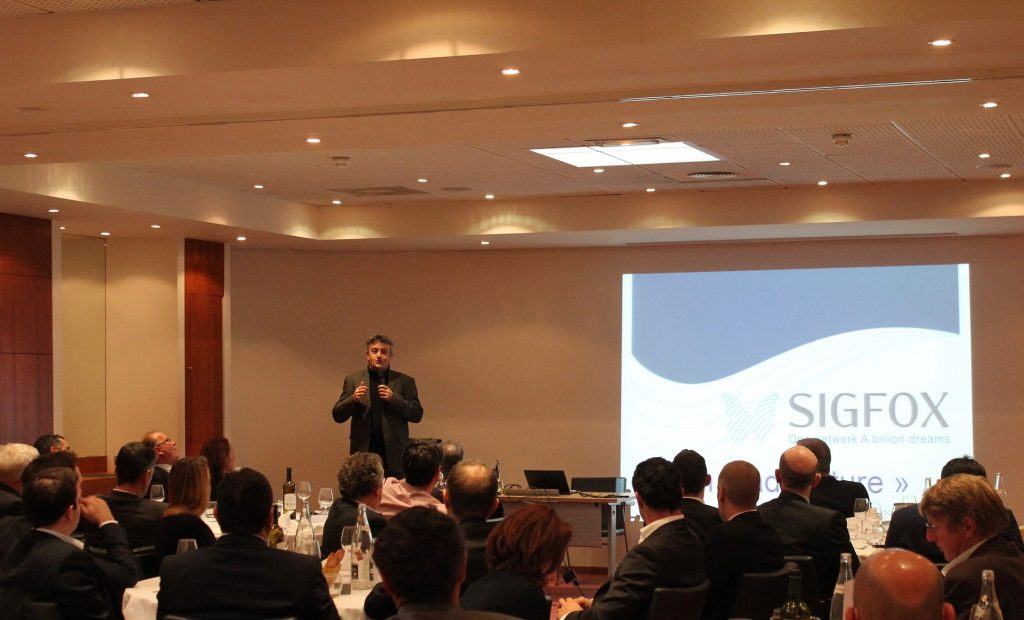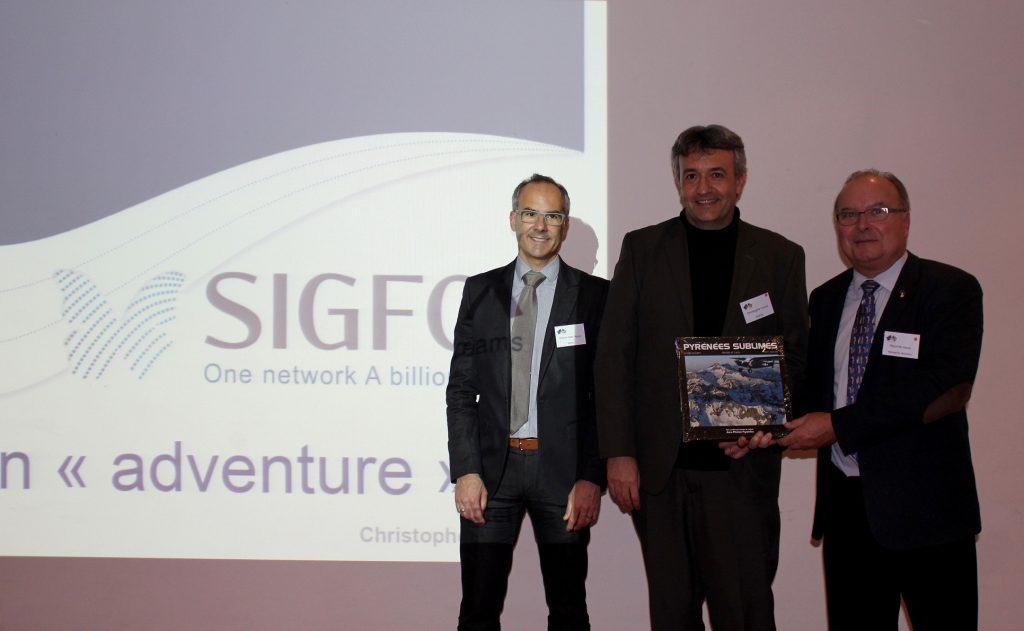TBS Aerospace MBA Delegates attending USAIRE Conference on IoT – January 20th, 2017
By Ms Camille Blain & Mr Arnaud Mentigny, Aerospace MBA Delegates, FT18

Mr. Christophe Fourtet, SIGFOX
On January 20th, 2017, two delegates from Toulouse Business School’s Aerospace MBA participated in USAIRE’s last business session. The role of IoT was at the heart of discussions, with co-founder of the French champion Sigfox, Mr. Christophe Fourtet, presenting the evolution of its company and its business model.
Sigfox’s DNA: digitalizing the physical world.
Sigfox, a French company building wireless networks to connect objects, was founded in 2009 by Ludovic Le Moan and Christophe Fourtet. Sigfox provides cellular connectivity for the Internet of Things in more than 29 countries spread around the world and for a population up to 471 million people. Sigfox welcomes clients notably willing to ensure predictive maintenance, asset management, or crop management. Through its devices, the French champion has already connected more than 8 million objects.
IoT emergence as data transfers dawned
As cellular communications emerged in the 90’s, digital telephony was deemed a major communication system. This triggered a large increase of transferred data and of the bandwidth. Yet, this technology quickly faced two limits: a significant band risk in term of security, along with a decrease in the efficiency of the system, when trying to increase the transfer rate. To solve these problems, operators were forced to implement more base stations, as close as possible to the customers.
As a radio engineer, Christophe Fourtet was well aware of these limits. Willing to provide solutions, he started exploring new ways of transferring data, which led him not to consider the latest technologies at that time, but rather an old one, namely called radio signals.
This technology implemented on cellular networks notably ensures long-range data transfers with low power consumption. Simultaneously, it also permits to decrease the bandwidth, the quantity of data transferred and the number of base stations.
In this regard, the strength of Sigfox compared to standard radio signals providers lies in its capacity to have valued this technology in the frame of the Internet of Things (IoT) way before competitors.

Mr Olivier Pedron Rockwell Collins, Mr Chistophe Fourtet SIGFOX, Mr Maurice Marais, President USAIIRE South West
Sigfox’s beginnings
Willing to find a complementary partner, Christophe Fourtet met Ludovic Le Moan, an entrepreneur specialized in machine-to-machine (M2M) communications, whose faced difficulties to connect M2M in a low-cost way. The perfect match indeed! Christophe Fourtet’s radio technology allowed Ludovic Le Moan to solve the problem of low-cost data transfer. In 2009, the new partners launched Sigfox with a view to building a global communication network for IoT through radio signals.
After a first demonstrator aiming at proving the potential of this revolutionary technology to private funds, interestingly, Christophe Fourtet and Ludovic Le Mohan attracted the interest of diversified investors, far from being restricted to the Telecom sector – the latter expressing strong reserves about IoT.
A second fundraising 18 months after permitted to demonstrate the viability of this technology, along with its fast and efficient deployment. Sigfox started to become attractive to actors that did not show interest before, until reaching 2,000 bases installed in France in 2011, an incredible performance for a startup.
One technology, unlimited applications
Sigfox network is using an ultra-narrow band (UNB) technology. Compared to a classical cellular system such as GSM, remote devices are here able to connect to that ultra-narrow band by using a very limited number of antennas and are also able to emit in the above-mentioned frequency band. Once the signal is send, that one is received and decoded by the closest base station, transferred to a “Cloud” and then forwarded through the network to servers. To increase the data rate transfer, fiber technology is used to connect base stations and servers. Clients are warned via the Sigfox application that a message is available for them. Sigfox network can be considered as a global network compared to a GSM network where a device is only connected to a base station (such as an antenna) which implies a roaming stage. Last but not least, Sigfox technology combines low power consumption and low operating cost.
In the IoT field, Sigfox asserts that its technology will be applicable to a large choice of applications: chemistry industry, distribution, entertainment, people & health monitoring, alarm tracking, weather prediction, etc. In fact, the scope of potential applications is unlimited.
Revenue Model
Christophe Fourtet closed his presentation by a short description of Sigfox’s revenue model. One of the company’s goals is to sell infrastructures to partners and to sell services based on metadata. The first step will be to propose a business model based on metadata, followed, whenever possible, by the sale of infrastructures. The ultimate goal is to increase the number of connected devices. One of the actual major issue is that the technology is difficult to implement with customers from the telecom sector as their business model are not yet ready for that kind of change.

TBS team






